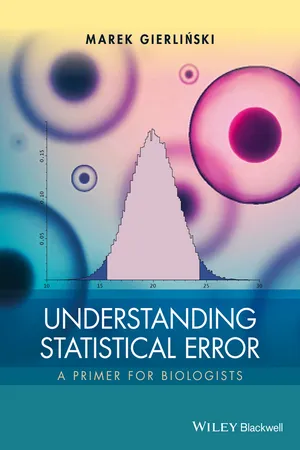
- English
- ePUB (mobile friendly)
- Available on iOS & Android
About this book
This accessible introductory textbook provides a straightforward, practical explanation of how statistical analysis and error measurements should be applied in biological research.
Understanding Statistical Error - A Primer for Biologists:
- Introduces the essential topic of error analysis to biologists
- Contains mathematics at a level that all biologists can grasp
- Presents the formulas required to calculate each confidence interval for use in practice
- Is based on a successful series of lectures from the author's established course
Assuming no prior knowledge of statistics, this book covers the central topics needed for efficient data analysis, ranging from probability distributions, statistical estimators, confidence intervals, error propagation and uncertainties in linear regression, to advice on how to use error bars in graphs properly. Using simple mathematics, all these topics are carefully explained and illustrated with figures and worked examples. The emphasis throughout is on visual representation and on helping the reader to approach the analysis of experimental data with confidence.
This useful guide explains how to evaluate uncertainties of key parameters, such as the mean, median, proportion and correlation coefficient. Crucially, the reader will also learn why confidence intervals are important and how they compare against other measures of uncertainty.
Understanding Statistical Error - A Primer for Biologists can be used both by students and researchers to deepen their knowledge and find practical formulae to carry out error analysis calculations. It is a valuable guide for students, experimental biologists and professional researchers in biology, biostatistics, computational biology, cell and molecular biology, ecology, biological chemistry, drug discovery, biophysics, as well as wider subjects within life sciences and any field where error analysis is required.
Frequently asked questions
- Essential is ideal for learners and professionals who enjoy exploring a wide range of subjects. Access the Essential Library with 800,000+ trusted titles and best-sellers across business, personal growth, and the humanities. Includes unlimited reading time and Standard Read Aloud voice.
- Complete: Perfect for advanced learners and researchers needing full, unrestricted access. Unlock 1.4M+ books across hundreds of subjects, including academic and specialized titles. The Complete Plan also includes advanced features like Premium Read Aloud and Research Assistant.
Please note we cannot support devices running on iOS 13 and Android 7 or earlier. Learn more about using the app.
Information
Chapter 1
Why do we need to evaluate errors?
A measurement without error is meaningless.—My physics teachers

Chapter 2
Probability distributions
Misunderstanding of probability may be the greatest of all impediments to scientific literacy.—Stephen Jay Gould
Table of contents
- Cover
- Title Page
- Copyright
- Dedication
- Introduction
- Chapter 1: Why do we need to evaluate errors?
- Chapter 2: Probability distributions
- Chapter 3: Measurement errors
- Chapter 4: Statistical estimators
- Chapter 5: Confidence intervals
- Chapter 6: Error bars
- Chapter 7: Propagation of errors
- Chapter 8: Errors in simple linear regression
- Chapter 9: Worked example
- Solutions to exercises
- Appendix A
- Bibliography
- Index
- EULA